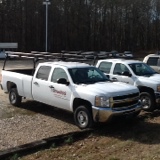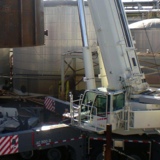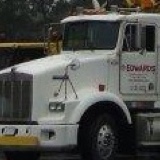Information
-
Client / Site / Location
-
Scope of Work
-
Conducted on
-
Prepared by
-
Document No.
1.0 - Job Tasks
-
1.1 - Pre work plan defining scope of work, job hazards, risk, prevention, and PPE (Personal Protective Equipment) has been completed, communicated to crew, and all parties have signed. (PTP, AHA, JHA, JSA, etc.)
-
1.2 - Inadequate administrative / risk controls? (examples: no job rotation, lighter loads, trolleys, lifting equipment, etc)
-
1.3 - Lack of training in risk controls and safe lifting techniques?
2.0 - Working at Heights
-
2.1 - Fall risks of 6 feet or more? (including voids, pits, and trenches)
-
2.2 - Lack of edge protection?
-
2.3 - Unsafe or incomplete edge protection?
-
2.4 - Unsafe or damaged harness or equipment?
-
2.5 - Incompatible lanyards, hooks, and equipment?
-
2.6 - Unlabeled or damaged body harness and lanyard?
-
2.7 - Unsafe anchor points?
-
2.6 - Lack of inspection for fall protection equipment?
-
2.9 - Lack of or improper use of fall protection equipment?
3.0 - Tools and Equipment
-
3.1 - Unsafe or damaged tools or equipment? (including missing or damaged guards)
-
3.2 - Incorrect tools or equipment for job? (e.g. grinding discs for cutting)
-
3.3 - Unsafe or incompatible attachments used with tools or equipment?
-
3.4 - Unlicensed operators?
-
3.5 - Lack of safe work instructions?
-
3.6 - Lack of training in safe operation, clean-up, and maintenance?
-
3.7 - Lack of Lock Out Tag Out procedures for cleaning, servicing and maintenance?
-
3.8 - Lack of daily inspection?
4.0 - Scaffolds
-
4.1 - Unlicensed persons erecting scaffold above 12 feet?
-
4.2 - Unsafe or incomplete scaffold?
-
4.3 - Lack of daily scaffold inspection?
-
4.4 - Incompatible scaffold components?
-
4.5 - Safe Work Load (SWL) exceeded? (tools, stored materials, number of persons)
5.0 - Lifting Equipment
-
5.1 - Unsafe lifting practices?
-
5.2 - Loads are not being lifted over persons or within 20 feet overhead power lines?
-
5.3 - Lack of maintenance, testing and inspection?
-
5.4 - Lack of Safety Work Load information displayed?
-
5.5 - Lack of daily inspection?
-
5.6 - Unsafe or damaged lifting equipment, including wire ropes, synthetic slings, chains, or hooks?
-
5.7 - Lifting equipment unlabeled or missing manufactures tag?
-
5.8 - Unlicensed operators?
-
5.9 - The WLL (Working Load Limit) of lifting equipment is not being exceeded?
6.0 - Ladders
-
6.1 - Unsafe or damaged ladders?
-
6.2 - Unsafe positioning or use of ladders?
-
6.3 - Ladder not properly secured?
-
6.4 - Ladder unsuitable for job? (e.g. metal ladder used for electrical work)
-
6.5 - All ladder labels are in place and legible?
7.0 - Hazardous Chemical (including fuel and oil)
-
7.1 - Unsafe storage location? (flammables near ignition sources, spills near stormwater drains, etc)
-
7.2 - Incompatible chemicals stored near each other?
-
7.3 - Inadequate spill containment equipment?
-
7.4 - Safety Data Sheets accessible on site?
-
7.5 - Lack of emergency spill and clean up procedures?
-
7.6 - Excessive quantities stored on site or in vehicles?
-
7.7 - Insufficient ventilation?
-
7.8 - Insufficient or incorrect PPE?
-
7.9 - Unsuitable storage containers? (unlabeled, improperly labeled, or stored in food grade containers)
8.0 - Emergency Response
-
8.1 - Lack of, or no emergency plans for site?
-
8.2 - Lack of, or inadequate first aid kits aid equipment for site?
-
8.3 - Unsuitable or inadequate communication equipment?
9.0 - Personal Protective Equipment (PPE)
-
9.1 - Lack of, or inadequate PPE
-
9.2 - Lack of system to issue, inspect, replace and monitor PPE?
-
9.3 - Lack of training in safe use, clean-up, and inspection of PPE?
10.0 - Work Environment
-
10.1 - Lack of, or inadequate amenities? (toilets, wash areas, lunch rooms, etc)
-
10.2 - Insufficient lighting?
-
10.3 - Inadequate housekeeping?
-
10.4 - Lack of, or inadequate noise/ vibration control?
11.0 - Electrical Hazards
-
11.1 - Unsafe electrical leads? (damaged or out of date inspection)
-
11.2 - Lack of GFCI protection?
-
11.3 - Working close to underground utilities?
-
11.4- Working close to overhead electrical lines?
-
11.5 - Overloading outlets?
-
11.6 - Leads placed on ground or on metal structures?
-
11.7 - Electrical equipment near water?
-
11.8 - Electrical equipment near flammables?
-
11.9 - Electrical equipment near chemicals that could cause damage?
-
11.10 - Electrical leads that may be damaged from contact with moving machinery parts?
-
11.11 - Electrical leads on work surfaces?
-
11.12 - Lack of Lock-out/tag-out (LOTO) procedures for electrical equipment?
12.0 - Environmental Hazards
-
12.1 - Lack of, or inadequate Environmental Management plan (EMP)?
-
12.2 - Lack of, or inadequate, dust suppression system?
-
12.3 - Lack of, or inadequate systems to prevent contaminants entering stormwater drains?
-
12.4 - Lack of, or inadequate system to reclaim and account for scrap or recyclable material?
13.0 - Administrative Procedures
-
13.1 - Lack of, or inadequate Site Safety Plan?
-
13.2 - Failure to obtain permits before work began? (Work,Hot Work, Excavation, Confined Space, Lifting, etc.)
-
13.3 - Lack or, or inadequate, supervisory arrangements?
-
13.4 - Lack of, or inadequate training, licenses, skills, experience?
-
13.5 - Lack of, or inadequate incident notification procedures?
-
13.6 - Lack of, or inadequate, routine inspections, monitoring, audits?
-
13.7 - Lack of, or inadequate consultative arrangements and project directives?
Corrective Actions
-
Enter any corrective actions that will be undertaken
Sign Off
-
Job Number
-
On site representative
-
Auditor's signature









